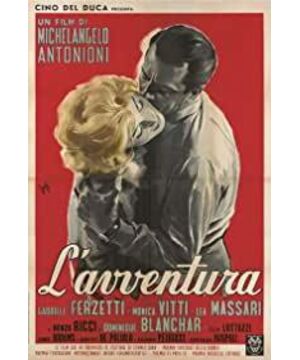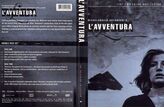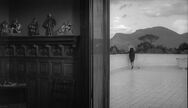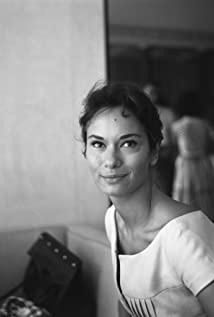1.
At the beginning of the film, the camera followed Anna walked into the construction site and met his father. The messy background implies a contradiction between the father and daughter that is not easy to reconcile. The two fell into embarrassment because of their marriage to Sandro, and finally separated.
Generally speaking, the figure on the left side of the screen is the agreed power center and holds the current right to speak. In this scene, Anna first draws from the right, and her father takes the initiative on the left;
Then, Anna mentioned going out to sea to play, and walked to the left, taking the right to speak, and it meant her determination to dedicate her love to Sandro;
But his father's words changed: "I also want to get used to a new life... a life that a father should have", while emphasizing his fatherhood, he regained his initiative. In addition, the father has changed from being level with his daughter in the horizontal direction to occupying the foreground by himself, oppressing his daughter to the background, and his discourse advantage becomes more and more obvious;
Subsequently, his father began to educate Anna in the tone of "being a father", and the dialogue went to a dead end. Anna became irritable and didn't want to face it, so she hid away. The two-person picture is divided into single-person pictures, and the contradiction between the two is escalated;
But Anna didn't want to remain in such a stalemate, she chose to end this topic as soon as possible, and go to sea with Claudia as soon as possible. So, as a daughter, she reluctantly framed her father again and kissed goodbye.
Claudia waited a long time. The two drove away from the construction site. Starting from a messy and deserted place, it heralds the dangers and adventures that will appear in this sea trip and the subsequent story.
2. On the
island, Anna and Sandro had an argument about their marriage. It doesn't seem to be intense, but there are destructive waves hidden. The two sat on the spot first. Sandro on the first floor and the rocks on the third floor could not hold Anna in the second depth of field. It seemed that Anna could only be forced to accept Sandro to get married immediately. Wish
But then, a cross-axis lens broke the deadlock and liberated Anna from the predicament. At the same time, we can clearly see Sandro's facial expressions-it can be said that all the "hole cards" have been spread out, making himself passive-and Anna's firm ignorance attitude. Anna's initiative to break up with her is almost a foregone conclusion.
"I want to stay alone... let's be separated a little longer." Anna got up, and the lens gave Anna a close-up shot. The sea horizon in the background almost exceeds Anna's head, giving the illusion that she is about to be submerged in sea water. And this is exactly what Anna wants to pursue, a complete disappearance. The friend behind him left the mountain and expressed this very cooperatively.
But Sandro was still not reconciled, and immediately stood beside Anna, trying to fill the gap beside Anna, and cut off her desire to leave her;
Reluctantly, Anna was resolute, and Sandro knew that she was powerless (as you will see later, Sandro didn't really love Anna), so she turned and left, leaving the ocean to Anna, letting her fend for herself.
3.
After Anna disappeared, everyone went to the island to look around. Many long-range shots have appeared throughout the passage, and the characters blended into the scene and became part of the environment. The effect of lyricism through scenery is self-evident, alienated, desolate and confused, and the effect is excellent.
The feelings between Sandro and Claudia also burst into this passage. The heavy rain trapped the three in the small house. The stable relationship of the triangle made Sandro unable to exert a "fist" on Claudia, and his quarrel with Anna was found out by the other two and was blamed and then isolated. Outside the painting
The boatman was considered to have saved Sandro's life, his appearance broke the existing balance, and the four quickly formed a two-by-two combination. Sandro's nature allowed him to stand with Claudia naturally, and he kept his eyes on. Antonioni used a kerosene lamp here to vividly express what is called "the spark of love";
Claudia is a sensitive person, and she immediately understood Sandro's thoughts. She rushed into the rain, shouting Anna's name loudly, hoping that she would come back alive, but also that she would be able to stop Sandro and prevent her possible future immoral crimes when she came back. The heavy rain is the reason for the characters to enter the cabin, and the opportunity for Sandro to show love to Claudia. Here, Claudia's complex emotions are exposed.
So far, Claudia and Sandro have never looked at each other in a single shot. But on the second day, the gust of wind failed to cool the relationship between the two of them, but it became more and more intense. An accidental fall, the two made a single, first eye contact;
Although it was a front and back shot, the two of them failed to complete the true feeling of the same frame, and also carried an inner contradictory meaning of the cross axis, but everyone knew that they had achieved the so-called "cross-border", and Will be out of control. Besides, Claudia is wearing Anna's shirt at this time-as the saying goes, if you own a woman's clothes, you own everything about her.
4.
Claudia's love for Sandro is constantly strengthening, and the train scene reaches a climax at about the midpoint of the film. Claudia wanted to leave alone by train, but at the same time wanted Sandro to be with her. Such contradictory and complex psychology can also be traced in the language of the camera outside of the actor's performance.
Claudia sat in her seat and pondered, and the unbalanced composition chart revealed the meaning of "vacancy"-the original two-person seat was missing the opposite person. This is the expression of Claudia's state of mind;
But after Sandro appeared, Claudia became more contradictory and indecisive, so that the stubborn Sandro couldn't bear it, and she forced herself to be in the same frame with Claudia many times, but ended up in no trouble;
In the other two seats, a man and a woman chatted with great interest. Claudia peeked outside and smiled happily. It is this kind of love that she wants to pursue. It is not a vacancy, nor is it sitting opposite, but sitting next to oneself;
But Claudia did not have the courage to accept such love. Two doors, let two people be separated by one side again.
I don't know whether this passage intentionally uses "two" and "two" as images, and the repeated pairs of things are imaginative. No, the eye-catching number "2" on the train leather seems to be trying to tell us something.
5.
The scene on the roof of the church took place after Claudia completely dedicated herself to Sandro. Some of the scheduling and arrangements here are also intriguing.
Sandro leaned aside, telling the story of his past work to make money. After contacting the article, we can learn that Sandro is paving the way for his marriage proposal. But Antonioni is here to put Sandro's oppressive feeling in front of the Gothic buildings. Combined with the coldness, gloom and mystery brought by the Gothic style, one has to doubt the reliability of Sandro's rhetoric and the true purpose of his proposal;
On Claudia's side, the blue sky and white clouds set off her, which means that she has opened up and accepted Sandro completely, without any doubt about the authenticity of this relationship. Sandro then took the opportunity to further occupy Claudia.
Then Sandro initiated a marriage proposal-in a messy venue. A few hemp ropes separated the two, and the yin and yang face formed by Sandro's exposure to sunlight also hinted at an unhappy ending in the future. At the end of the scene, Claudia was still immersed in happiness, but the authorities were fans, the twine seemed to form a giant net in the composition, and she had fallen into a point where she could not break free.
Sixth,
let's talk about the ending. Claudia found Sandro mingling with other women, ran out of the residence, weeping in the ruined willow. Another wonderful use of scene blending;
Sandro came, knowing that the mistake he had committed was irreparable, and sat down in the chair in the foreground secretly hurt. The two of them faced each other one after the other, forming a physical distance from a psychological distance. The broken wall represents sadness and history. Perhaps this relationship will become history; but at the same time, it can be noticed that although the slope will form a natural slanted composition, the camera did not accommodate it, but deliberately adjusted it. The slope makes the character still look horizontal. This is probably implying that the two are not incompatible, and the relationship will not become history.
Sure enough, Claudia chose to forgive, but it was forgiving at a price. I think the most beautiful shot of the whole film appears here: Claudia strokes Sandro's hair, looking into the endless distance. But on the other side of them, there was an icy rock, blocking the line of sight to the distance. Claudia's state of mind may be exactly like this: Although she feels cold, she still chooses to dedicate her remaining love to Sandro. Sandro had a chance to get all the sky, but only half of the scenery was left because of his fault. Perhaps here, Antonioni used the language of the lens to convey a richer message, but the meaning I read from it must not deviate too far from the original category:
cherish.
View more about L'Avventura reviews









